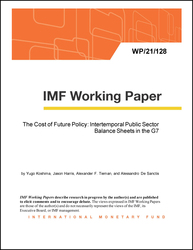
The Cost of Future Policy: Intertemporal Public Sector Balance Sheets in the G7
The Cost of Future Policy: Intertemporal Public Sector Balance Sheets in the G7
READ MORE...
Volume/Issue:
Volume 2021
Issue 128
Publication date: May 2021
ISBN: 9781513573335
$18.00
Add to Cart by clicking price of the language and format you'd like to purchase
Available Languages and Formats
| English |
Prices in red indicate formats that are not yet available but are forthcoming.
Topics covered in this book
This title contains information about the following subjects.
Click on a subject if you would like to see other titles with the same subjects.
Economics- Macroeconomics , Public Finance , Economics / General , International - Economics , balance sheet framework , negative Intertemporal Net Financial Worth , INFW 0 , evolution of INFW , INTERTEMPORAL NET , Financial statements , Health care spending , Fiscal stance , Pension spending , Global
Summary
This paper compiles the Intertemporal Public Sector Balance Sheets for all G7 countries and examines their relationship with government borrowing costs. In 2018, all G7 countries have negative Intertemporal Net Financial Worth (INFW), falling short of their intertemporal budget constraint. A decomposition of the evolution of INFW shows that short-term fluctuations are mainly driven by fiscal policy changes, while in the long run demographic changes and health and pension obligations play a larger role. We find that on average a 10 percentage point of GDP increase in INFW reduces the (future) 10-1 year sovereign yield curve spread by 2.8 basis points. This results suggest that financial markets pay attention to governments’ future policy obligations, in addition to its current assets and liabilities.
Copyright © 2010 - 2025
Powered by:
AIDC



